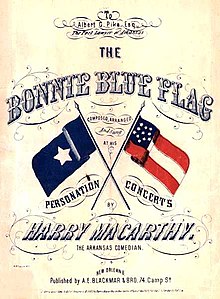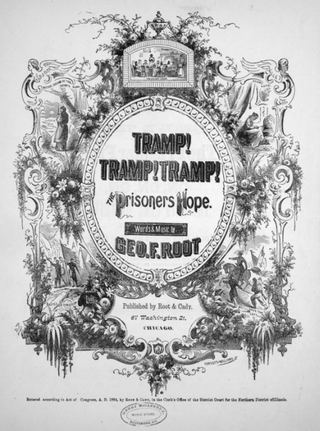As with many songs from the time of the American Civil War, this song had multiple versions for both the Union and Confederate sides. One Union version, written by J. L. Geddes, in 1863, [11] [12] a British-born colonel who immigrated to the U.S., was called "The Bonnie Flag With the Stripes and Stars". Singing of Unionism and equality, it went:
Another version by one Mrs. C. Sterett and published by S.T. Gordon of 538 Broadway Street in New York went:
My Name is Tim McDonald, I'm a native of the Isle
I was born among old Erin's Bogs when I was but a child
My Father fought in '98 for liberty so dear;
He fell upon old Vinegar Hill, like an Irish Volunteer!
Then raise the Harp of Erin, boys, The flag we all revere!
We'll fight and fall beneath its folds, Like Irish Volunteers!
Then raise the Harp of Erin, boys, The flag we all revere!
We'll fight and fall beneath its folds, Like Irish Volunteers!
When I was driven from my home by an oppressor's hand
I cut my sticks and greased my brogues and came o'er to this land
I found a home and many friends, and some that I love dear;
Be jabbers! I'll stick to them like bricks and an Irish Volunteer!
Then fill your glasses up, my boys, and drink a hearty cheer!
To the land of our adoption and the Irish Volunteers!
Then fill your glasses up, my boys, and drink a hearty cheer!
To the land of our adoption and the Irish Volunteers!
Now when the traitors in the south commenced a warlike raid
I quickly then laid down my hod, to the devil went my spade!
To a recruiting office then I went, that happened to be near
And joined the good old 69th, like an Irish Volunteer!
Then fill the ranks and march away! No traitors do we fear!
We'll drive them all to blazes, says the Irish Volunteer!
Then fill the ranks and march away! No traitors do we fear!
We'll drive them all to blazes, says the Irish Volunteer!
Now, when the Prince of Wales came over here, and made a hullabaloo
Oh, everybody turned out, you know, in gold and tinsel too;
But then the good old 69th didn't like these lords or peers
They wouldn't give a damn for kings, the Irish Volunteers!
We Love the Land of Liberty, its laws we will revere!
"But the devil take the nobility!" says the Irish volunteer!
We Love the Land of Liberty, its laws we will revere!
"But the devil take the nobility!" says the Irish volunteer!
Now if the traitors in the south should ever cross our roads
We'll drive them to the devil, as Saint Patrick did the toads;
We'll give them all short nooses that come just below the ears,
Made strong and good of Irish hemp, by Irish volunteers!
Then here's to brave McClellan whom the army now reveres!
He'll lead us on to victory, the Irish volunteers!
Then here's to brave McClellan whom the army now reveres!
He'll lead us on to victory, the Irish volunteers!
Now fill your glasses up, my boys, a toast come drink with me
May Erin's Harp and the Starry Flag united ever be;
May traitors quake, and rebels shake, and tremble in their fears,
When next they meet the Yankee boys and Irish volunteers!
God bless the name of Washington! that name this land reveres;
Success to Meagher and Nugent, and their Irish volunteers!
God bless the name of Washington! that name this land reveres;
Success to Meagher and Nugent, and their Irish volunteers!

















